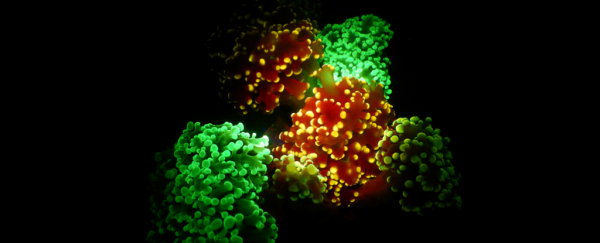The oceans are full of magical marine life that have spawned ecosystems brimming with biodiversity. Corals, which come in all shapes, sizes and colors, are no exception. Some species even glow in the dark.
Now a team of Israeli scientists have figured out why that might be so. With glowing green and yellow tentacles, deep-reef corals might fluoresce bright colors to lure their prey towards them for a snack.
"Despite the gaps in the existing knowledge regarding the visual perception of fluorescence signals by plankton, the current study presents experimental evidence for the prey-luring role of fluorescence in corals," says coral reef researcher Or Ben-Zvi of Tel Aviv University, who led the research.
Most reef-building corals bask in the shallow waters so their resident algae can capture sunlight as it filters down from the ocean surface. These are the coral reefs with their photosynthetic zooxanthellae that we know and love.
But other intrepid coral species actually manage to grow at greater depths, as deep as 6,000 meters (20,000 ft) below the surface in the dark, cold, deep sea. (Sadly, however, even they cannot escape human impacts).
The researchers behind this new study thought that these deep-water corals, many of which are fluorescent, might use light to attract their prey, such as itty-bitty plankton, into their fold – similar to other deep-sea dwellers which emit bioluminescence.
But they needed to test that theory, which they dubbed the 'light-trap' hypothesis.
"Many corals display a fluorescent color pattern that highlights their mouths or tentacle tips," explains marine ecologist and senior author Yossi Loya of Tel Aviv University.
This ability to fluoresce and attract prey seems like a pretty essential adaptation for corals stuck on the seafloor, and "especially in habitats where corals require other energy sources in addition [to] or as a substitute for photosynthesis," Loya adds.
A bunch of other ideas have been proposed though, to explain why coral fluoresce. For instance, the 'sunscreen' hypothesis suggests that fluorescence might protect bleached corals from further heat stress and light damage. Boosting photosynthesis might be another possible explanation.
But mesophotic corals, which grow in low, blue-shifted light, are a little different – with no evidence as yet that their fluorescence offers any sort of protection or energetic boost.
So Ben-Zvi and her colleagues dove in, looking at coral species which grow at light-dwindling depths and rely on predation more than photosynthesis for food.
In a series of lab experiments, the team tested whether teeny shrimp (Artemia salina) preferred a green or orange fluorescent target over clear, reflective or matt-colored targets positioned on the opposite side of a tank.
Indeed, the shrimp were attracted to and swam towards the fluorescent signal.
 A close-up of glowing corals. (Tel Aviv University)
A close-up of glowing corals. (Tel Aviv University)
Similar results were found when the researchers set up experiments in the Gulf of Eilat, located at the northern tip of the Red Sea. A native crustacean that falls prey to corals in the Gulf, Anisomysis Marisrubri preferred fluorescent cues over reflective targets but an introduced species of fish larvae did not.
Lastly, the researchers compared predation rates amongst different colored Euphyllia paradivisa corals that were collected from the Gulf of Eilat at depths of 45 meters (148 ft) and transported back to the lab.
It turns out that fluorescent green corals enjoyed higher predation rates than their yellow-fluorescing mates, gobbling up more A. salina shrimp in 30 minutes. And when the experiment was repeated under red, not blue lights, which do not excite coral fluorescence, there was no difference in shrimp consumed.
"In its natural habitat in the mesophotic reefs of Eilat, the yellow morph of E. paradivisa was found to be the least abundant, which can now be potentially explained by the lower prey attraction to this color found in the present study," Ben-Zvi and colleagues write.
 The experimental setup. (Tel Aviv University)
The experimental setup. (Tel Aviv University)
Of course, it's important to note that this study looked at just one species of mesophotic coral. More research is also needed to better understand how plankton and other coral-sustaining crustaceans perceive color – which likely differs among species, locations and life stages.
But regardless, the study findings underscore why corals – which are the bedrock of biodiverse ocean ecosystems – are so vital to protect. Luckily, we know how.
The study was published in Communications Biology.
